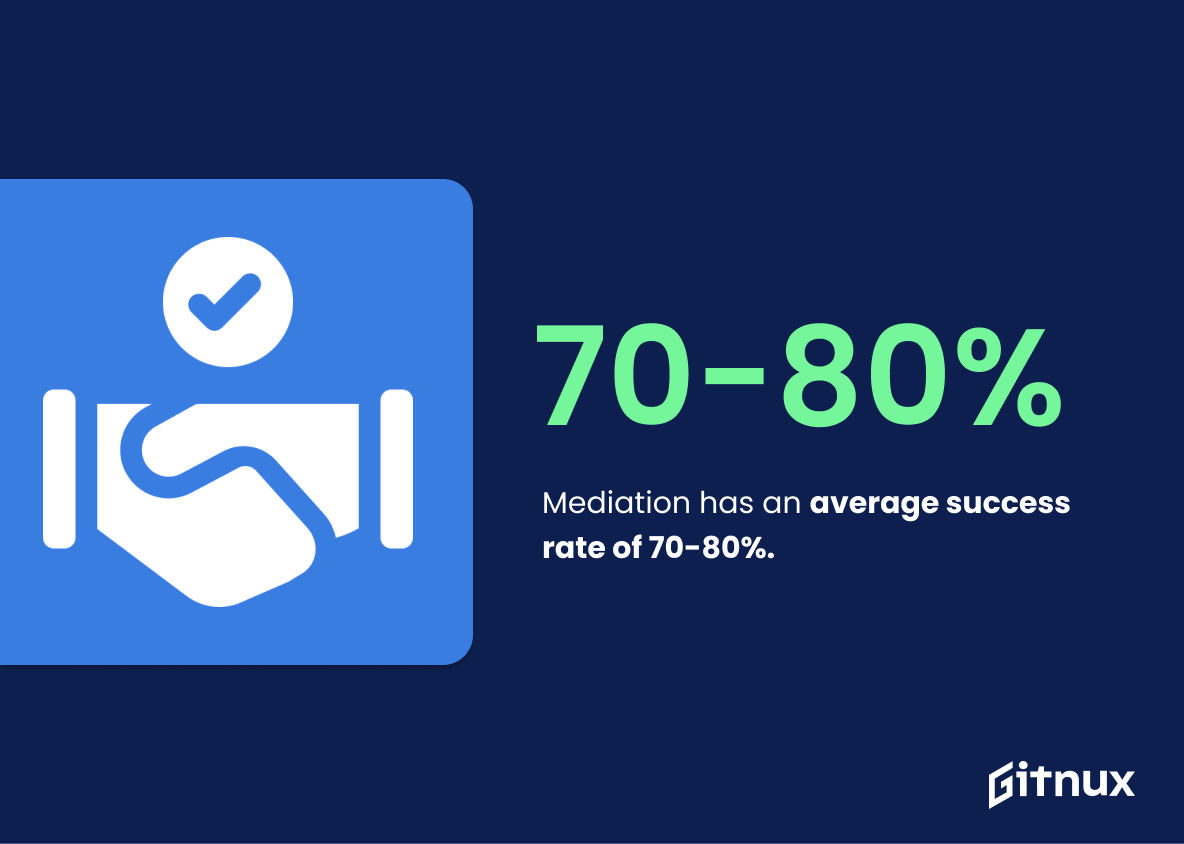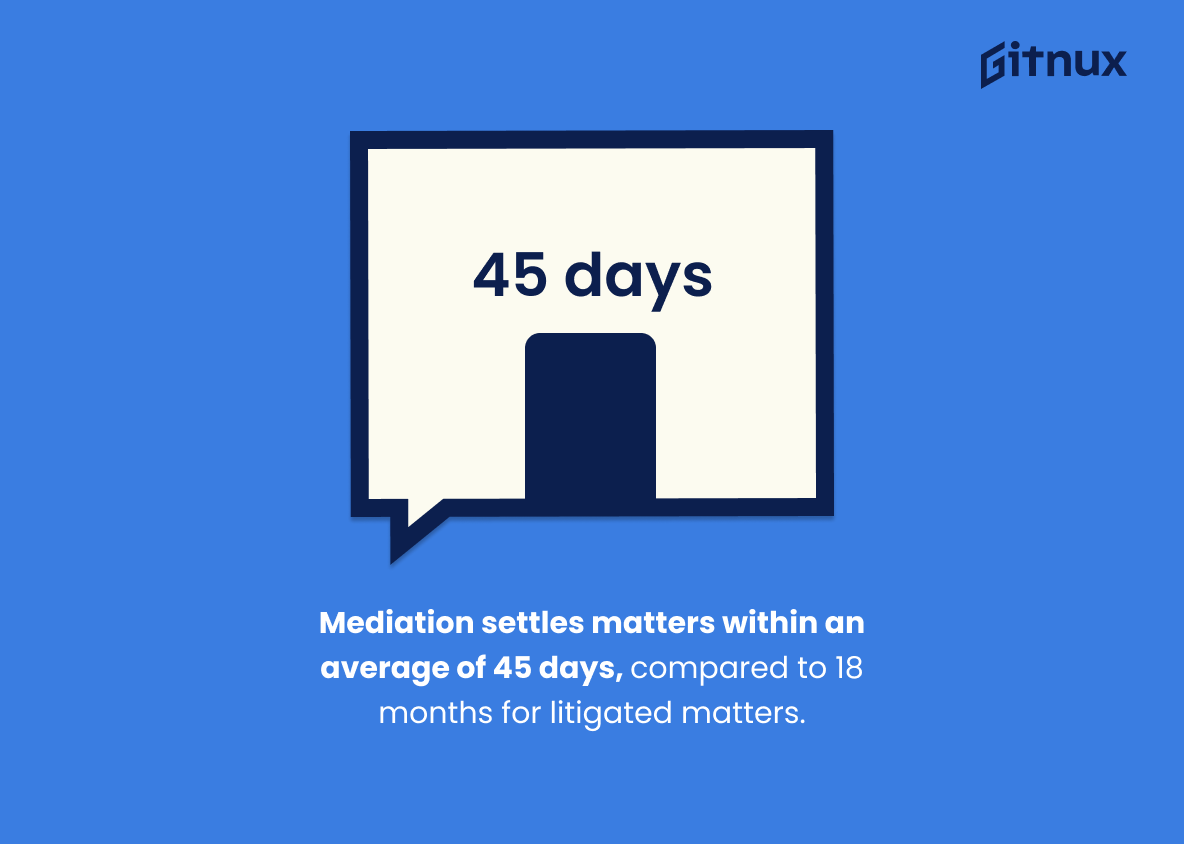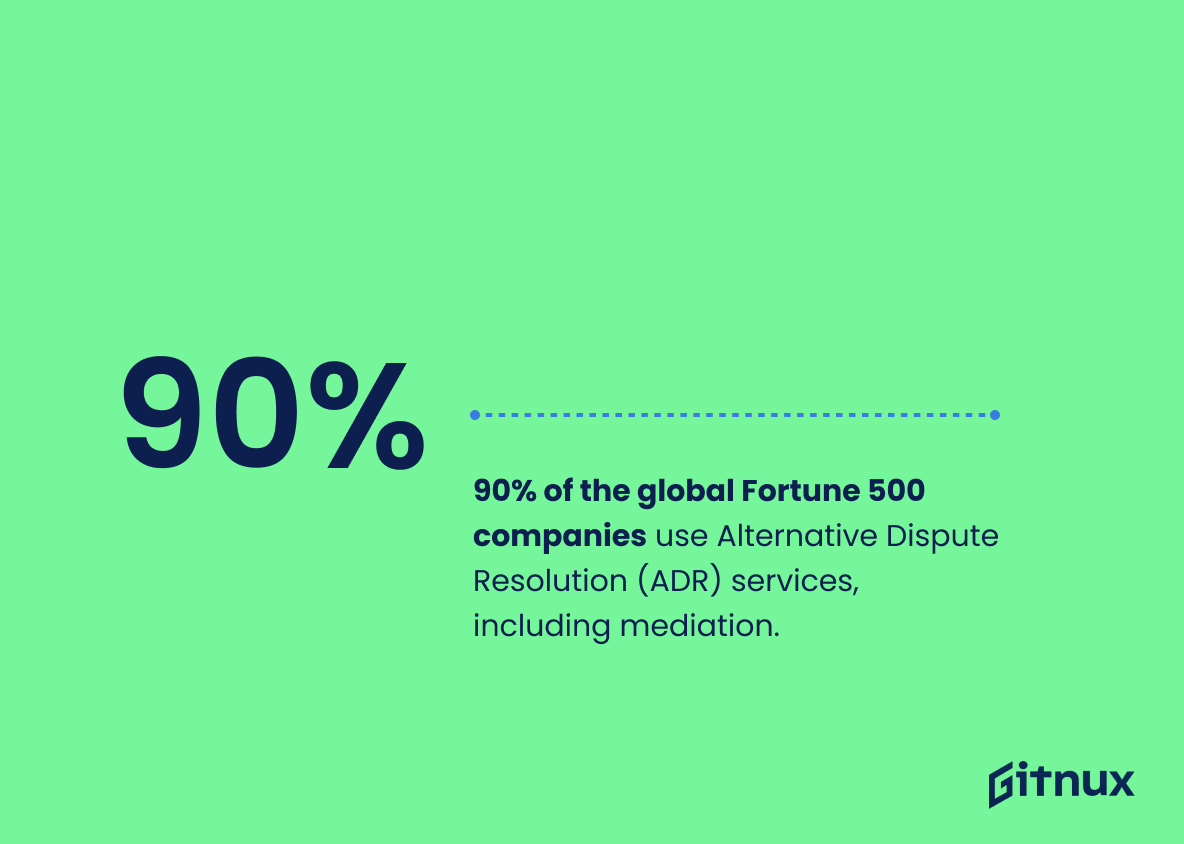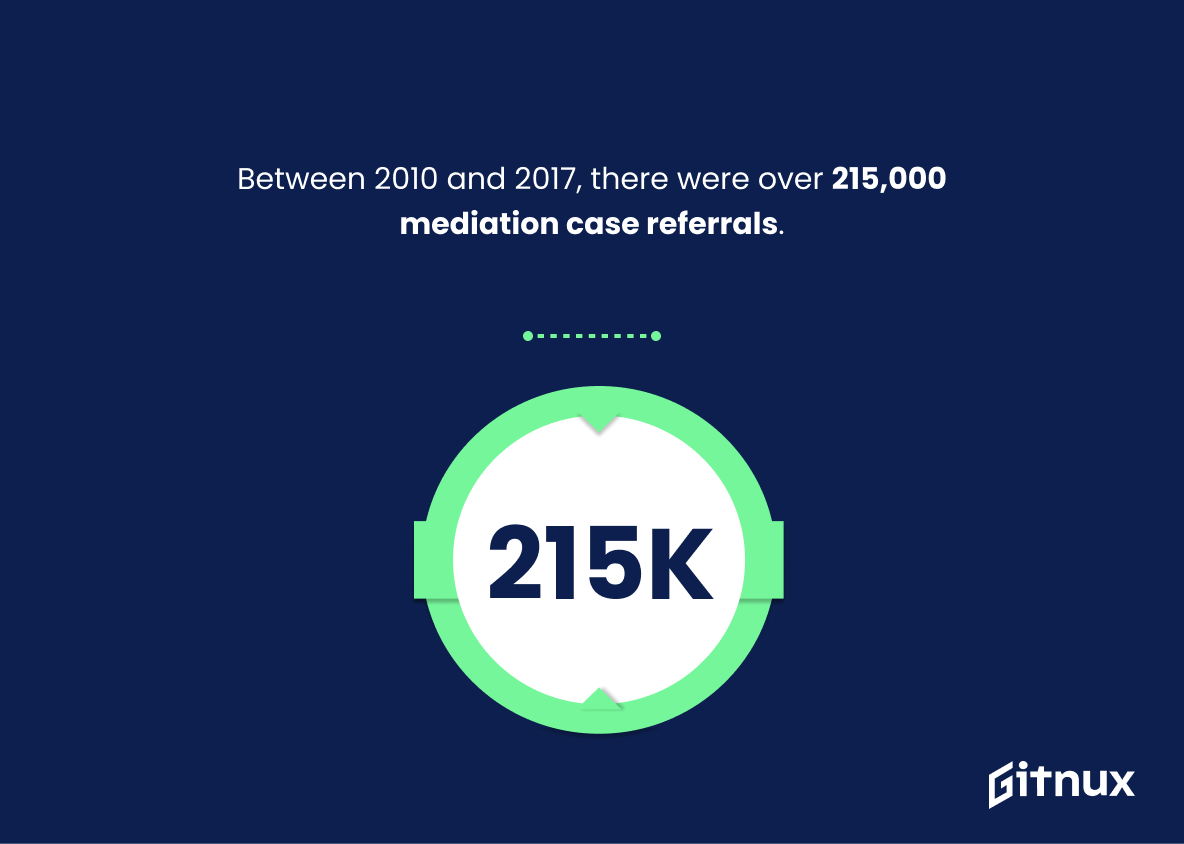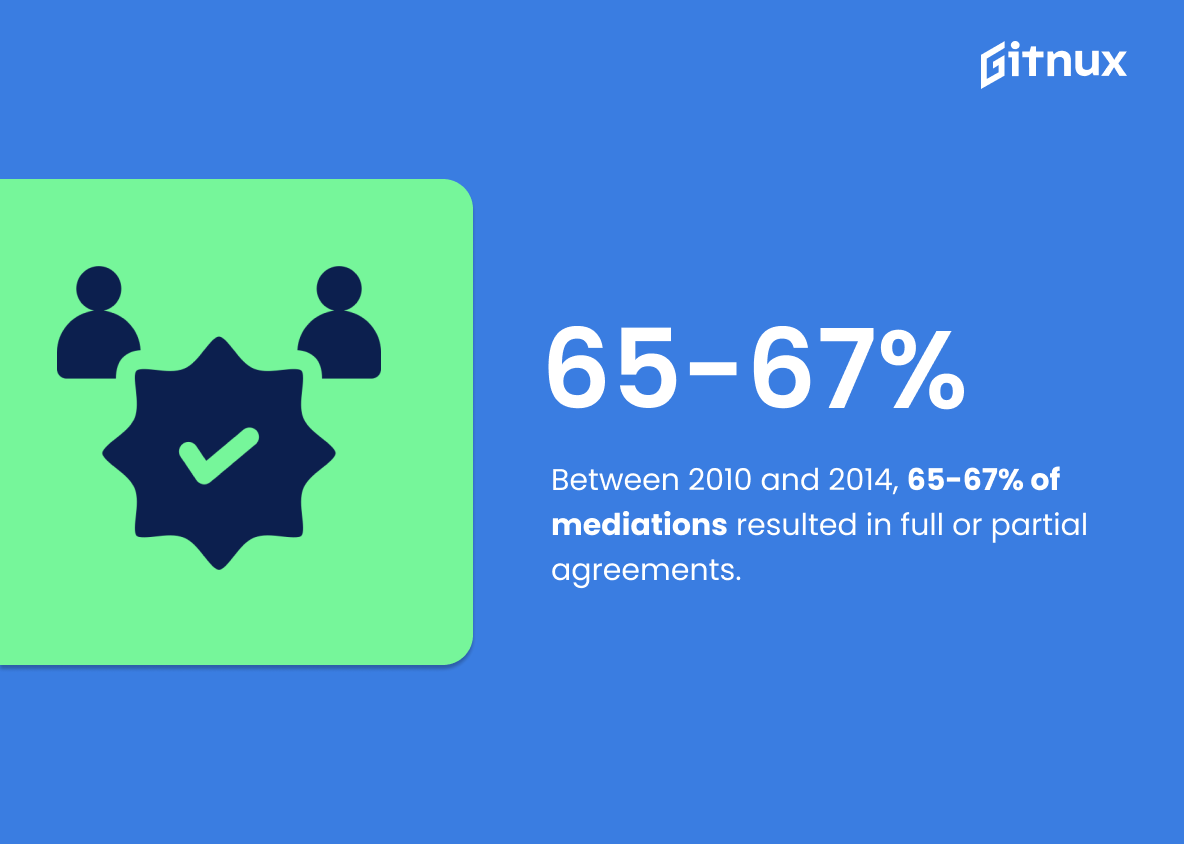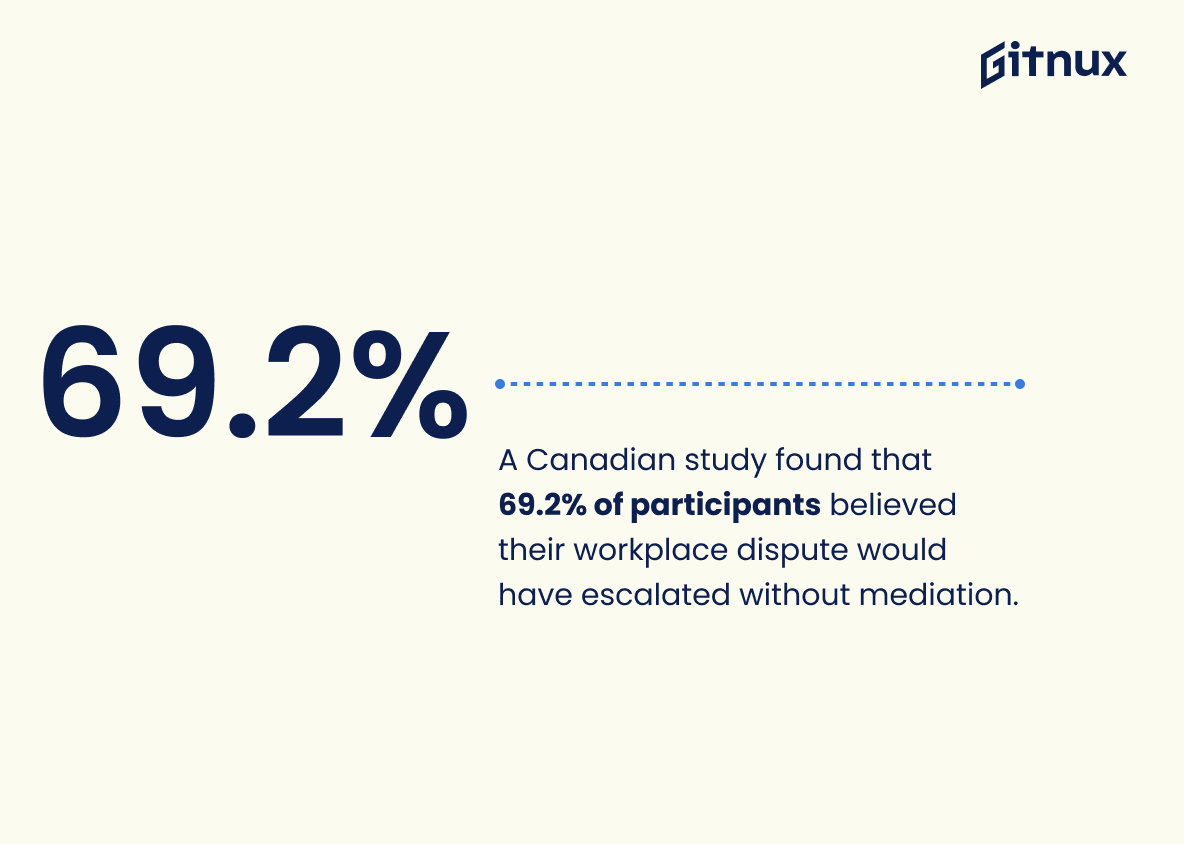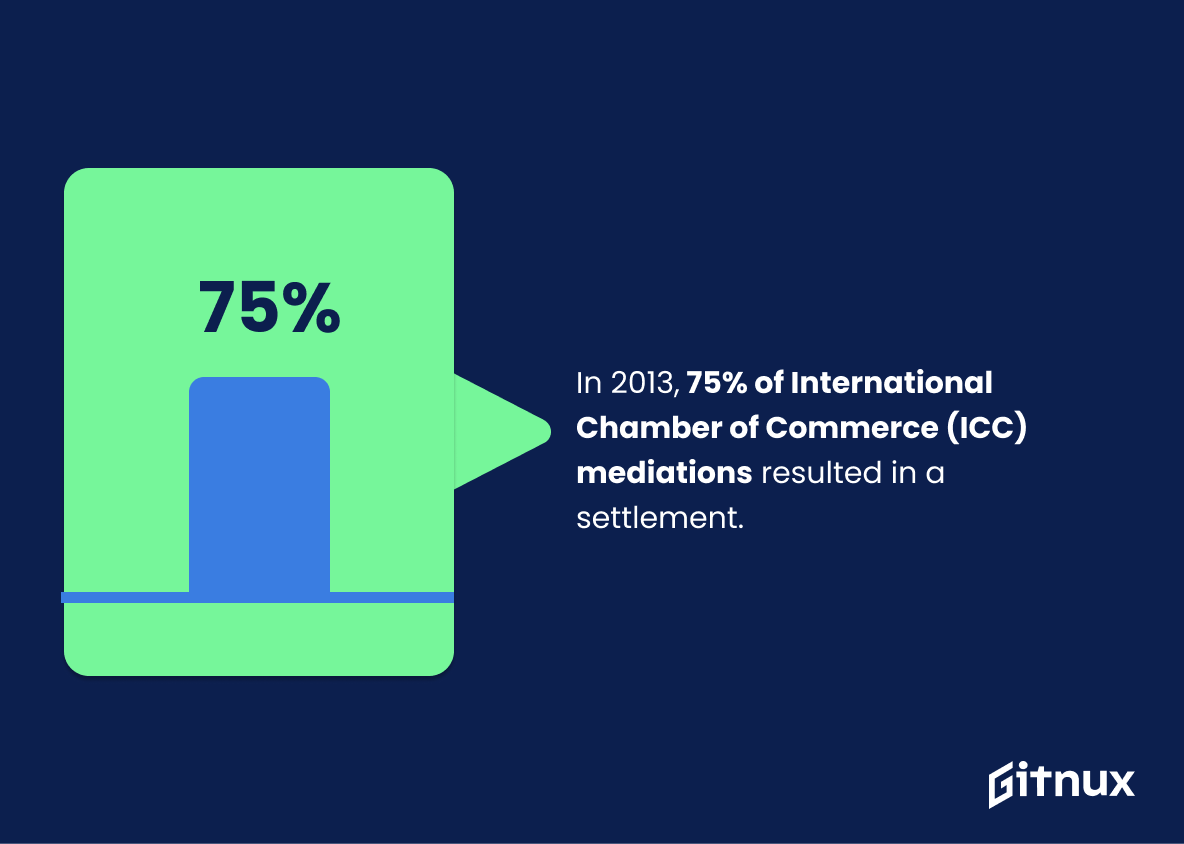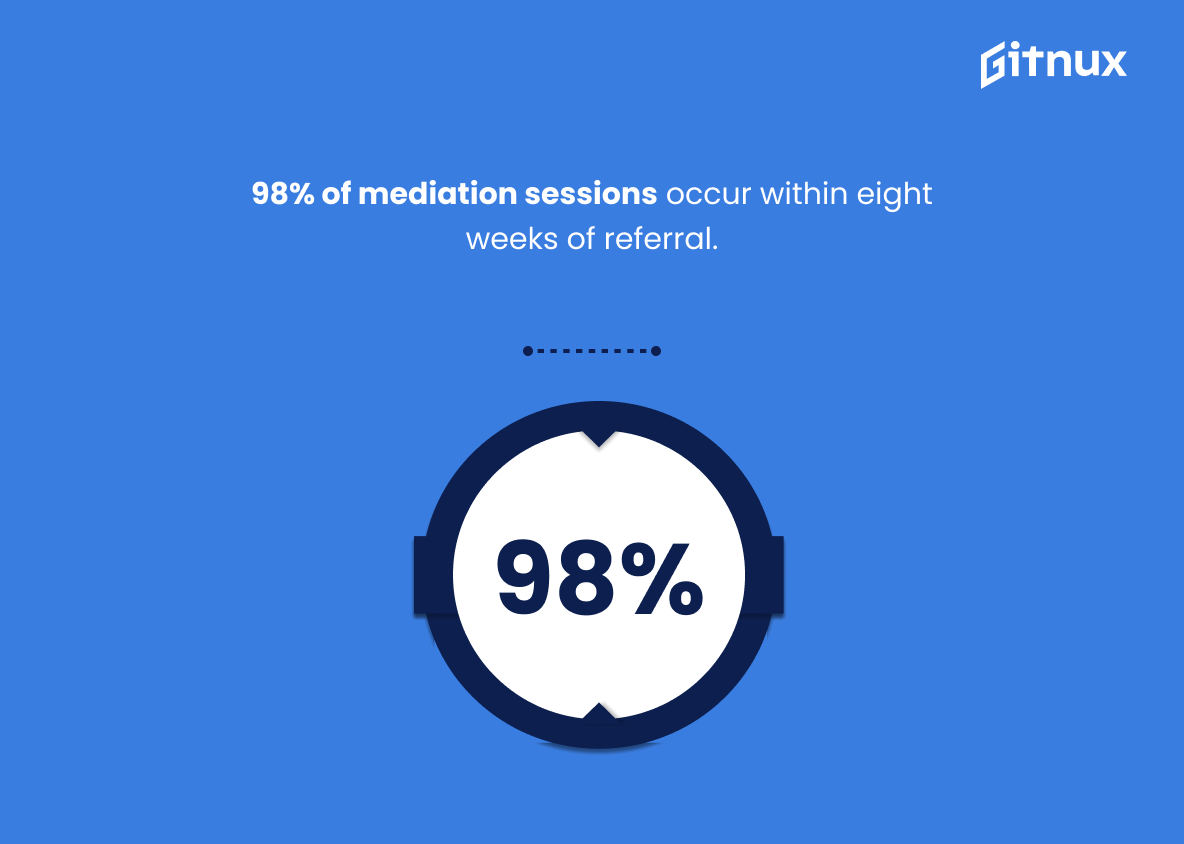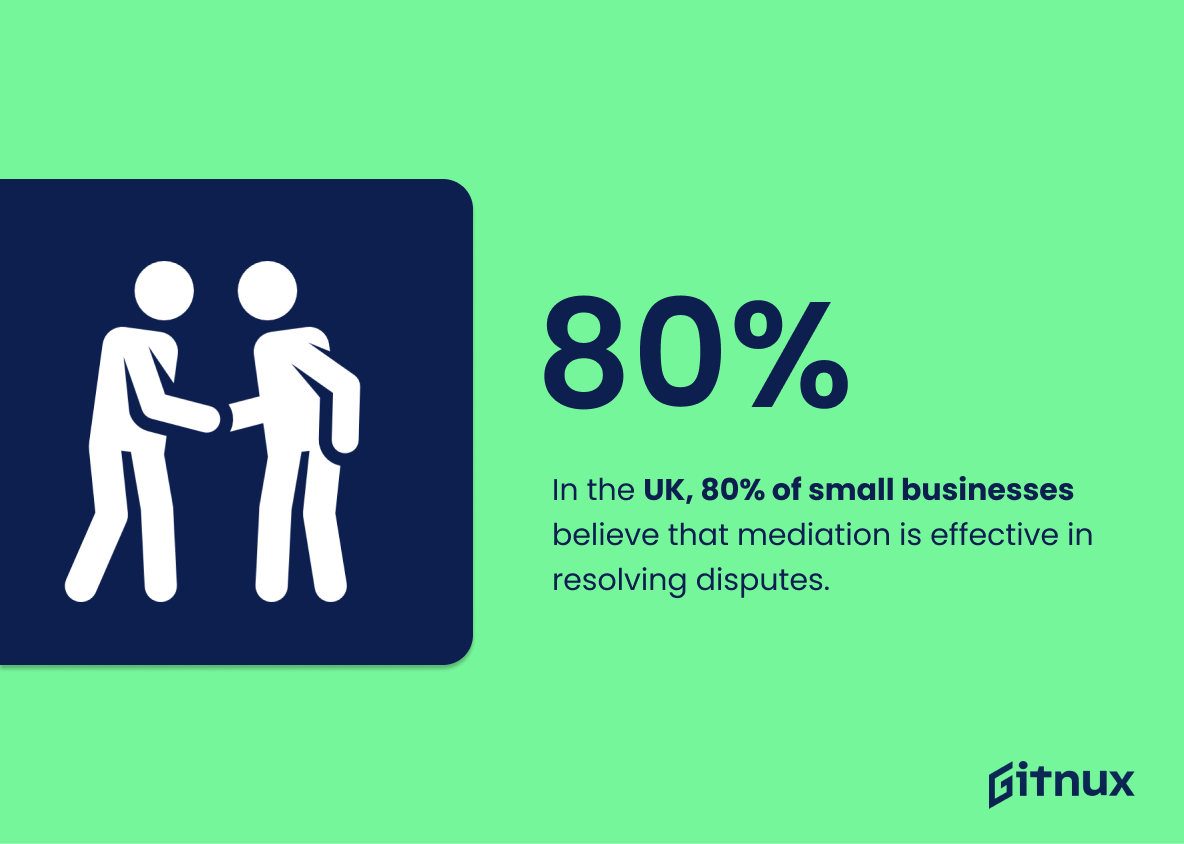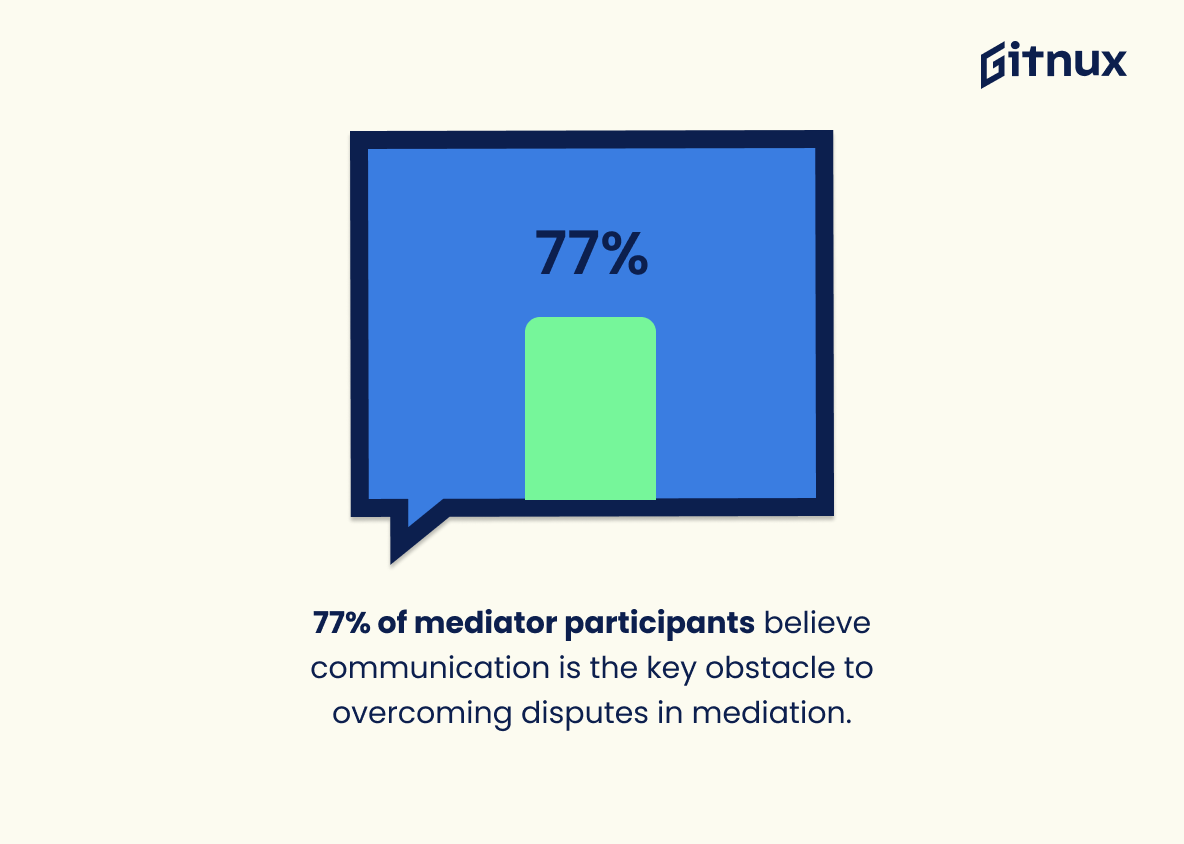Mediation, a highly successful dispute resolution method, has seen action from over 75% of employers to improve workplace implementation. Strikingly, 90% of workplace disputes go unreported. Mediation boasts a 70-80% success rate, and saw a 22% rise between 2014 and 2016. Efficiently, it resolves issues within an average of 45 days, compared to litigation’s 18 months.
Moreover, 90% of Fortune 500 companies use Alternative Dispute Resolution (ADR), such as mediation. Divorce cases mediated cost 40-60% less than litigated ones, with 20% of divorces negotiated via mediation. Labor mediations settle 94% of cases within 10 days, yielding an 80-90% satisfaction rate, far surpassing the court proceeding satisfaction rate of 50%.
Between 2010 and 2017, over 215,000 case referrals led to 65-67% full or partial agreements. German and Finnish studies recorded 86% and 80% mediation success rates, respectively. Additionally, a Canadian study found that 69.2% of participants believed workplace conflict would escalate without intervention. The ICC noted 75% settlements, with a typical session length of 8 weeks. Lastly, 80% of small businesses reported mediation effectiveness, while 77% of respondents and 84% of attorneys recognized the key roles of communication and client satisfaction, respectively.
This statistic is a testament to the importance of mediation in the workplace. It shows that employers recognize the value of mediation and are taking steps to ensure that it is implemented in their organizations. This is a positive sign that mediation is becoming more widely accepted and utilized, which can lead to improved communication, collaboration, and productivity in the workplace.
90% of workplace disputes are not reported.
This statistic is a stark reminder of the prevalence of workplace disputes that go unreported. It highlights the need for employers to create an environment where employees feel comfortable and safe to report any issues they may have. Mediation can be a powerful tool to help resolve workplace disputes, but if employees are not reporting them, then the potential benefits of mediation are not being realized.
Mediation Statistics Overview
Mediation has an average success rate of 70-80%.
The fact that mediation has an average success rate of 70-80% is a testament to its effectiveness as a dispute resolution tool. It shows that mediation is a viable option for resolving conflicts, and that it can be a successful way to reach a mutually beneficial agreement. This statistic is a powerful reminder that mediation can be a powerful tool for resolving disputes and should be considered when looking for a resolution.
Mediation settles matters within an average of 45 days, compared to 18 months for litigated matters.
This statistic is a powerful testament to the effectiveness of mediation as a dispute resolution method. It demonstrates that mediation can provide a much faster resolution to disputes than litigation, allowing parties to move on with their lives in a fraction of the time. This is especially important for those who are looking for a quick and cost-effective way to resolve their disputes.
90% of the global Fortune 500 companies use Alternative Dispute Resolution (ADR) services, including mediation.
This statistic is a powerful testament to the effectiveness of mediation services. It shows that the vast majority of the world’s most successful companies have recognized the value of mediation and have chosen to use it as a means of resolving disputes. This is a strong indication that mediation is an effective and reliable way to resolve conflicts, and it is a testament to the trust that these companies have in the process.
In divorce cases, mediation costs on average 40-60% less than litigation.
The fact that mediation costs on average 40-60% less than litigation is a powerful statistic that speaks volumes in the context of a blog post about Mediation Statistics. This statistic highlights the financial benefits of mediation, making it an attractive option for those looking to resolve their disputes without breaking the bank. Furthermore, it demonstrates the effectiveness of mediation as a cost-effective alternative to litigation.
Between 2010 and 2017, there were over 215,000 mediation case referrals.
This statistic is a powerful indicator of the growing popularity of mediation as a means of resolving disputes. It shows that more and more people are turning to mediation as an alternative to litigation, and that the process is becoming increasingly accepted as a viable option for resolving conflicts. This is an important development, as it suggests that mediation is becoming a more widely accepted and respected form of dispute resolution.
Between 2010 and 2014, 65-67% of mediations resulted in full or partial agreements.
This statistic is a testament to the effectiveness of mediation as a dispute resolution tool. It shows that the majority of cases that go through mediation end with a successful outcome, either a full or partial agreement. This indicates that mediation is a viable option for resolving disputes, and that it can be a cost-effective and time-efficient way to reach a resolution.
A Finnish study found that 80% of mediated cases resulted in an agreement.
This statistic is significant in the context of the blog post about Mediation Statistics because it demonstrates the effectiveness of mediation as a dispute resolution tool. It shows that the majority of cases that go through mediation end with an agreement, indicating that the process is successful in helping parties come to a mutually beneficial outcome. This is an important point to consider when evaluating the efficacy of mediation.
A Canadian study found that 69.2% of participants believed their workplace dispute would have escalated without mediation.
This statistic is a powerful testament to the effectiveness of mediation in resolving workplace disputes. It shows that the majority of participants in the Canadian study felt that mediation was the key to preventing their dispute from escalating. This indicates that mediation is an invaluable tool for preventing workplace disputes from becoming more serious and damaging.
In 2013, 75% of International Chamber of Commerce (ICC) mediations resulted in a settlement.
This statistic is a testament to the effectiveness of mediation as a dispute resolution tool. It shows that the majority of cases that go through the International Chamber of Commerce (ICC) mediation process end in a settlement, indicating that the process is successful in helping parties reach an agreement. This is an important point to make in a blog post about mediation statistics, as it demonstrates the value of mediation as a viable alternative to litigation.
98% of mediation sessions occur within eight weeks of referral.
This statistic is a testament to the efficiency of mediation sessions. It shows that the process is quick and effective, allowing parties to resolve their disputes in a timely manner. This is important because it means that parties can move on with their lives without having to wait for a long period of time for a resolution. Additionally, it demonstrates that mediation is a viable option for resolving disputes, as it is both fast and effective.
In the UK, 80% of small businesses believe that mediation is effective in resolving disputes.
This statistic is a powerful testament to the efficacy of mediation in resolving disputes. It shows that the majority of small businesses in the UK have experienced the positive effects of mediation and are confident in its ability to bring about successful outcomes. This statistic is an important piece of evidence to include in a blog post about mediation statistics, as it provides a strong indication of the effectiveness of mediation in the UK.
A study found that 77% of mediator participants believe communication is the key obstacle to overcoming disputes in mediation.
This statistic is a powerful indicator of the importance of communication in the mediation process. It suggests that the majority of participants recognize the need for effective communication in order to resolve disputes. This highlights the need for mediators to be skilled communicators in order to help parties reach a successful resolution. Furthermore, this statistic can be used to inform the development of mediation strategies and techniques that focus on improving communication between parties.
Conclusion
Mediation is an increasingly popular form of dispute resolution, with statistics showing that over 75% of employers have taken action to improve mediation in the workplace. It has a high success rate, with 90% of disputes not reported and 70-80% settled through mediation. In addition, it can be much faster than litigation – taking on average 45 days compared to 18 months for litigated matters – and more cost effective too; divorce cases mediated are 40-60% cheaper than those going through court proceedings.
The evidence suggests that mediation is highly successful in resolving disputes quickly and efficiently while also providing satisfaction rates between 80-90%. This makes it an attractive option for businesses looking to resolve conflicts without resorting to costly legal battles or damaging relationships further. With 94% of labor mediations settling within 10 days and 65-67 % resulting in full or partial agreements between 2010 and 2014, there’s no doubt that this method should be seriously considered when faced with any kind of conflict situation.
References
0. – https://www.thebalancesmb.com
1. – https://www.mediate.com
2. – https://www.fmcs.gov
3. – https://www.openknowledge.worldbank.org
4. – https://www.justice.gc.ca
5. – https://www.cipd.co.uk
6. – https://www.crnhq.org
7. – https://www.cpradr.medium.com
8. – https://www.iccwbo.org
9. – https://www.thetimes.co.uk
10. – https://www.julkaisut.valtioneuvosto.fi
11. – https://www.imimediation.org
12. – https://www.nj.gov
13. – https://www.divorceandyourmoney.com
